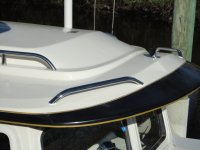thataway
Well-known member
- Joined
- Nov 2, 2003
- Messages
- 21,700
- Reaction score
- 70
- C Dory Year
- 2007
- C Dory Model
- 25 Cruiser
- Hull Identification Number
- DOR25652A707
- Vessel Name
- thataway
primative":fh0l56y5 said:I am trying to envision how these items are hanging/fastened so they are not in the way and hitting you when its rougher, going in and out the door? Are they on the inside of the cabin, on the bulkhead next to the hinged side of the door?
Regarding the tether lines you use if having to go to the gunnels/ bow when it's rough. How is this set up on your boat? Is it attached to the roof rails? I assume the inflatable PFD you keep by the door has the harness feature to secure you?
Tom
Tom, The inflatable PDF are hung from double coat hooks which are high on the aft bulkhead by the hinged side of the door, there is a small bungee cord at the bottom of the PFD to hold them in place.
Yes, there are two large "D" rings on the bottom of each PFD which snap with a spinnaker snap shackle (allows rapid detachment with a pull of a beaded lanyard). We have extra hand rails on the aft edge of each side of the outboard house, and also forward eyebrow on each side, so the tether can be clipped into these, or a vinyl covered cable (which we use for dinghy security) can also be placed between these hand holds. At the very bow, we would clip into the foredeck cleat. On our ocean crossing sailboats we had
"jacklines" set up all of the time we were offshore: one continuous line (inner with 3/16" SS cable covered with 3/4" hollow tubular nylon), from the very stern to the very bow on both sides). We do not have this on the C Dory.
Hardee--excellent--also it is a good idea to test the auto inflation part of the set up. Most PFD have a "bobbin", with tablet which dissolved in water, and those need to be replaced at least every 3 years. So this putting our PFD in water and seeing how it inflates, or jumping in the lake will assure that it does not pop out of the fabric as the vests did in the tragedy discussed in this thread.


